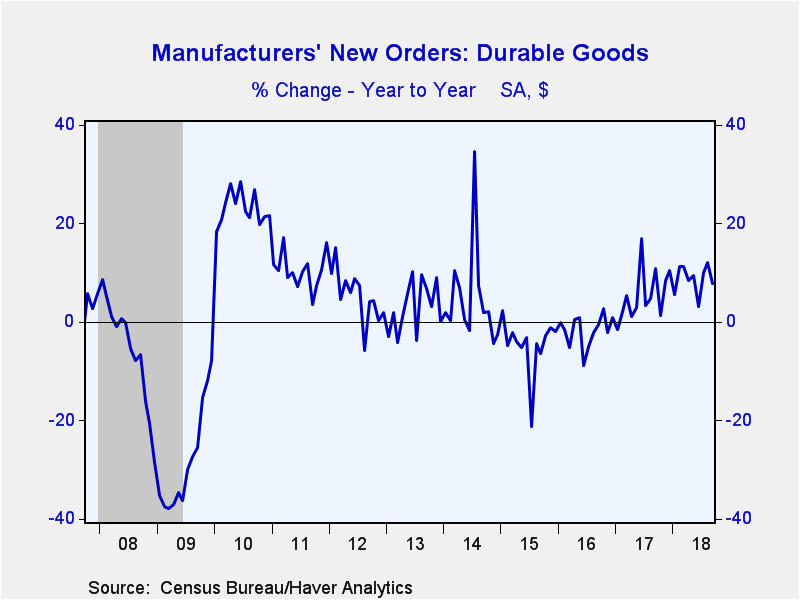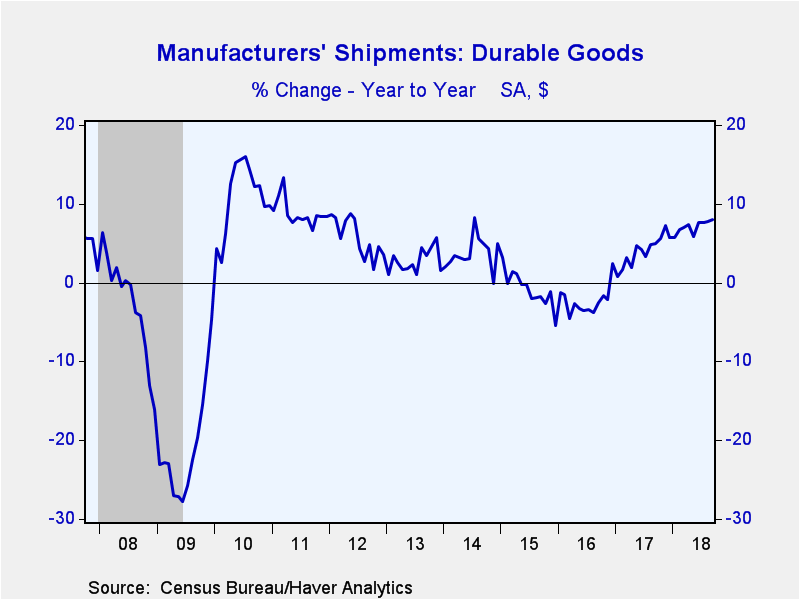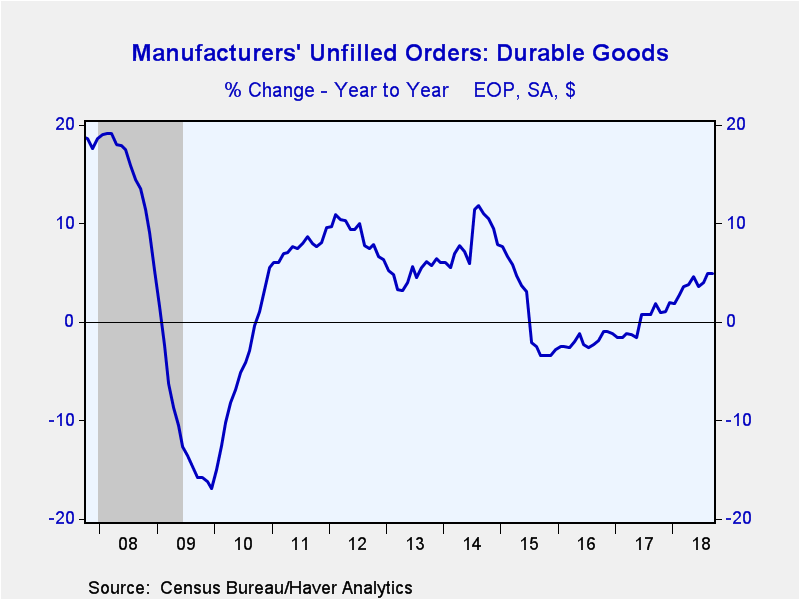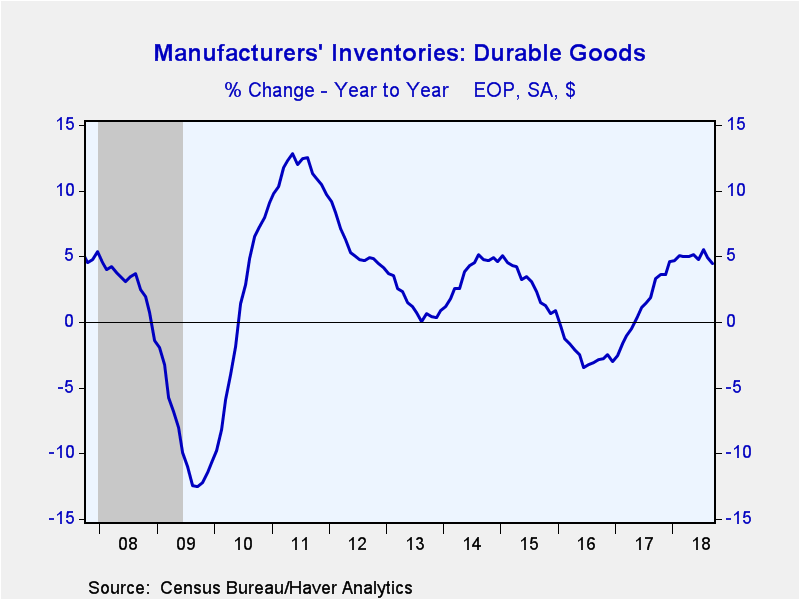 Global| Oct 25 2018
Global| Oct 25 2018U.S. Durable Goods Orders Improve Unexpectedly
by:Tom Moeller
|in:Economy in Brief
Summary
New orders for durable goods increased 0.8% (7.9% y/y) during September following a 4.6% August jump, revised from 4.5%. A 1.9% decline had been expected in the Action Economics Forecast Survey. The rise in orders was heavily [...]
New orders for durable goods increased 0.8% (7.9% y/y) during September following a 4.6% August jump, revised from 4.5%. A 1.9% decline had been expected in the Action Economics Forecast Survey.
The rise in orders was heavily influenced by a 15.8% jump in orders for aircraft & parts which followed a 50.5% surge. Defense aircraft orders more than doubled m/m. Transportation sector orders overall gained 1.9% (11.4% y/y) helped by a 1.3% rise (11.2% y/y) in orders for motor vehicles & parts.
Outside of the transportation sector, durable goods orders ticked 0.1% higher (5.9% y/y) in September after gains of roughly 0.3% in each of the prior four months. These modest increases pulled the three-month rise in orders down to 2.0% (AR) from a high of 15.7% in April.
Weakness in orders in the capital goods sector have played a large role in that slowdown. Overall nondefense capital goods orders declined 2.4% (0.7% y/y) last month after a 7.3% August jump. Outside of aircraft, orders eased 0.1% (+1.9% y/y) following a 0.2% dip. Three-month growth fell to 4.7% from a high of 14.9% as of June.
A 0.7% decline (+5.9% y/y) in fabricated metal orders figured largely in that softening as it followed a 0.6% rise. Orders for electrical equipment & appliances also eased 0.5% (+6.0% y/y), reversing a 0.6% gain. Orders for computers & electronic products were little changed (5.2% y/y) following a 0.7% decline. Orders for computers & electronic products fell 0.4% (+11.7% y/y) after a 1.2% drop. Working higher were machinery orders by 0.8% (0.9% y/y) following a 0.1% uptick. Primary metals orders improved 0.1% (19.5%) following a 1.3% strengthening.
Shipments of durable goods jumped 1.3% (8.1% y/y) after a 0.9% rise. Outside of the transportation sector, shipments rose 0.3% (+6.6% y/y) following a 0.1% uptick. Unfilled orders for durable goods gained 0.8% (4.9% y/y) after a 0.9% rise. Outside of transportation, backlogs rose 0.4% (5.2%), the same as in August. Inventories of durable goods increased 0.7% (4.5% y/y) after a 0.2% drop. Inventories rose 0.6% (5.5% y/y) outside of the transportation sector following a 0.4% rise.
The durable goods figures are available in Haver's USECON database. The Action Economics consensus forecast figure is in the AS1REPNA database.
The Fed's latest Beige Book covering regional economic conditions can be found here.
| Durable Goods NAICS Classification | Sep | Aug | Jul | Sep Y/Y | 2017 | 2016 | 2015 |
|---|---|---|---|---|---|---|---|
| New Orders (SA, % chg) | 0.8 | 4.6 | -1.2 | 7.9 | 5.4 | -1.7 | -5.0 |
| Transportation | 1.9 | 13.2 | -3.6 | 11.4 | 3.4 | -0.7 | -6.3 |
| Total Excluding Transportation | 0.1 | 0.3 | 0.2 | 5.9 | 6.5 | -2.3 | -4.2 |
| Nondefense Capital Goods | -2.4 | 7.3 | -3.7 | 0.7 | 9.1 | -5.8 | -11.8 |
| Excluding Aircraft | -0.1 | -0.2 | 1.5 | 1.9 | 6.7 | -4.5 | -5.5 |
| Shipments | 1.3 | 0.9 | -0.1 | 8.1 | 4.0 | -2.4 | -0.8 |
| Unfilled Orders | 0.8 | 0.9 | 0.1 | 4.9 | 2.0 | -1.2 | -2.7 |
| Inventories | 0.7 | -0.2 | 1.3 | 4.5 | 4.6 | -3.0 | 0.9 |
Tom Moeller
AuthorMore in Author Profile »Prior to joining Haver Analytics in 2000, Mr. Moeller worked as the Economist at Chancellor Capital Management from 1985 to 1999. There, he developed comprehensive economic forecasts and interpreted economic data for equity and fixed income portfolio managers. Also at Chancellor, Mr. Moeller worked as an equity analyst and was responsible for researching and rating companies in the economically sensitive automobile and housing industries for investment in Chancellor’s equity portfolio. Prior to joining Chancellor, Mr. Moeller was an Economist at Citibank from 1979 to 1984. He also analyzed pricing behavior in the metals industry for the Council on Wage and Price Stability in Washington, D.C. In 1999, Mr. Moeller received the award for most accurate forecast from the Forecasters' Club of New York. From 1990 to 1992 he was President of the New York Association for Business Economists. Mr. Moeller earned an M.B.A. in Finance from Fordham University, where he graduated in 1987. He holds a Bachelor of Arts in Economics from George Washington University.










